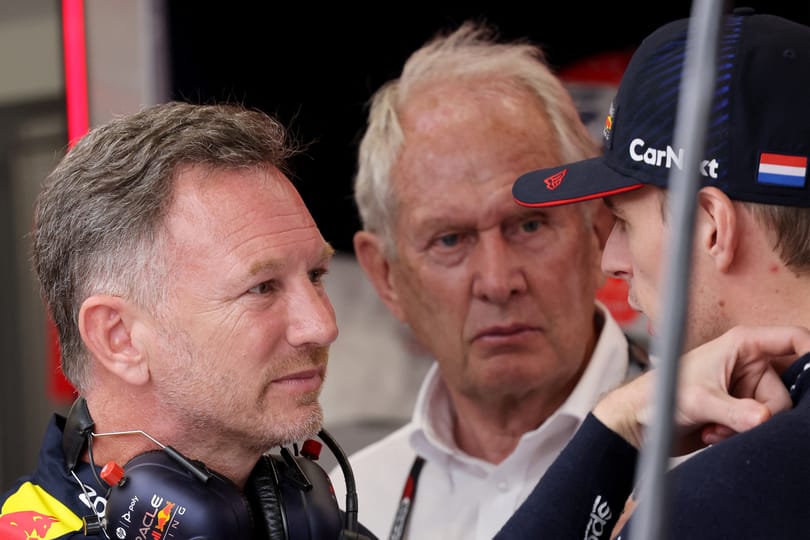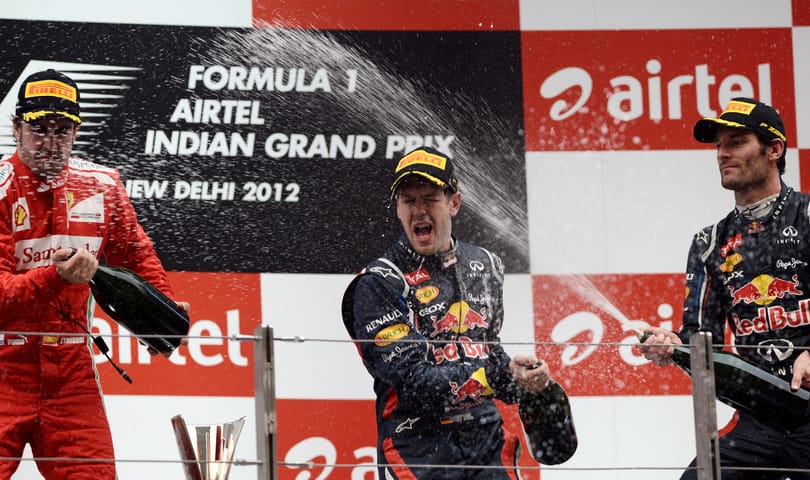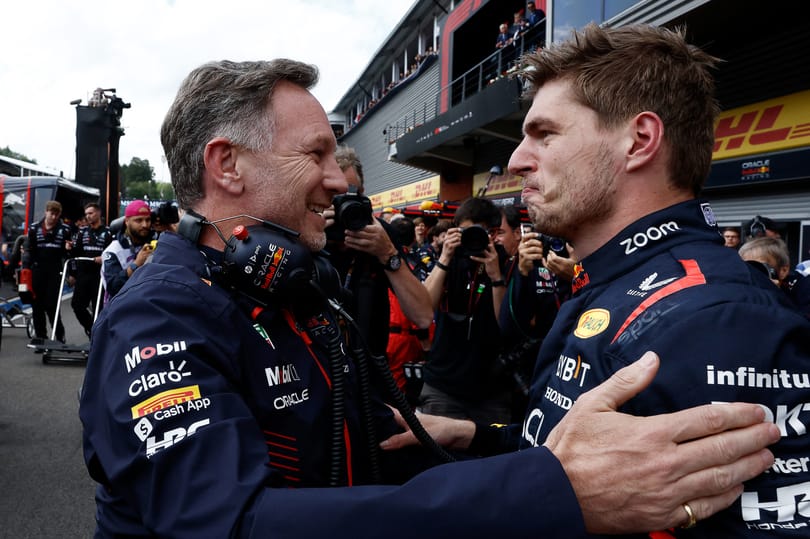"We would like to thank Christian Horner for his exceptional work over the past twenty years. With his tireless dedication, experience, expertise and innovative ideas, he has played a decisive role in making Red Bull one of the most successful and attractive teams in Formula 1. Thank you for everything, Christian! You will forever be a defining part of our team's history" - these are the few lines that came to Christian Horner in farewell, to whom Oliver Mintzlaff, Red Bull's managing director, said goodbye in a short statement on Wednesday.
After 20 years, 405 races, 124 race wins, 8 individual and 6 constructors' world championships, the CEO and team principal is leaving the energy drink brand team. Dark clouds have been gathering over his head for some time, but the timing of his departure is certainly surprising. We took a look at Christian Horner's fabulous career and recent decline.
He was a great wrestler, but his talent was not enough to compete.
In the business world, management is paramount. The best managers earn the highest salaries, and companies with high profit margins are said to be well-managed. Management is taught in universities, and bookstore shelves are flooded with textbooks that promise to turn the reader into an effective leader. But there are some lucky people who don't have to learn all this; it's all in their blood.
So is Christian Horner, who was appointed to the helm of Red Bull at the impudently young age of 31, with no previous F1 experience, after energy drink magnate Dietrich Mateschitz bought the then-suffering Jaguar team.
The world of racing has never been far from Horner, who was born in Leamington Spa, England, on November 16, 1973. He has a younger brother and an older brother, all three of them quite different, but they learned one thing from their parents: if you want to achieve something in life, you have to work hard.

Little Christian quickly realized that instead of wearing out his school desk, he belonged on the racetrack, but at that time he still imagined his future as a pilot. Once he pestered his parents until they bought him a used go-kart for his 12th birthday so he could drive it around the garden. Later it turned out that it was designed for racing, and from then on there was no question what fate awaited him. “This go-kart was a piece of shit, but it awakened in me the desire to race, and from then on I subordinated everything to it, the school ended up in the parking lot,” he said in an interview.
Thanks to his karting achievements, he won a scholarship from Renault in 1991, and after proving himself here, he made a deal with his parents. Instead of studying, they let him race for a year to see if he had a future as a driver, and if he didn't make it, he would go back to school. All his parents asked in return was that he apply to a university."I randomly chose a place and filled out the application forms, but I never intended to go to university. I don't even know where I applied," he recalled.
His first year was successful, he won the Formula-Renault championship, but in 1994 he faced difficulties: he ran out of money, but his goal was still to somehow get into Formula 1. One way to do this was to compete in Formula 3000, but he didn't even have enough money to buy a driver's seat with a good team. In the end, he decided to spend the rest of his money on his own car and try to race it himself.
I sold everything I owned, borrowed as much as I could – from the bank, my father (who only helped me on the condition that I would pay him back one day), and from anyone I could get my hands on. That’s how I managed to buy a car. I had to hire two engines, I persuaded Roly Vincini to be my race engineer, and we built the car in the workshop behind Roly’s house in Norfolk. I called the team Arden International. I was the team boss, the marketer, the secretary, the cook and the window cleaner – I did all the paperwork and administration. Our mechanic was a part-time guy who worked at the local Thresher’s. He’s now at McLaren
– he said in a 2012 interview.
The F3000 adventure ultimately lasted two years for him as a driver, and in a 1998 race in Portugal, after Juan Pablo Montoya incontrovertibly passed him, he realized, according to his own statement, that he would never be as good as the Colombian.
His"crazy deal" with Helmut Marko paved the way for him to F1
Horner's life turned out to be a turning point when he travelled all the way to Austria to buy a trailer for his team. The owner was a complete stranger to him at the time, a certain Dr. Marko. His father thought he was crazy when he told him that he had paid the full purchase price in advance and had hired a complete stranger to deliver it to Calais. In the meantime, he looked into who he had done the deal with and it turned out to be none other than Helmut Marko, a former Formula 1 driver who had also driven two F3000 cars at the time.

Horner and Marko were initially rivals, and then the Austrian became head of Red Bull's junior program, so he also oversaw the career of Vitantonio Liuzzi, who later made it to F1 with Toro Rosso. Horner wanted to get the rising Italian star to his team, but to do so he had to make a risky deal."Helmut paid about half of our minimum costs, and on top of that I asked him to pay $50,000 for every race we won. He went for it. We won nine out of ten races that year, without that I think we would have gone bankrupt. He liked my attitude and my confidence," said Horner, who was already eyeing F1.
He negotiated with Eddie Jordan, but he considered the amount offered for his team “ridiculous”, and then mentioned his plan to Marko, who invited him to Salzburg to meet Dietrich Mateschitz, the head of Red Bull, who at that time aimed to buy Jaguar. Jaguar’s F1 record was poor, despite the full power of Ford behind the team. Over five seasons, several well-known managers took turns at the helm of the team – including Bobby Rahal and Niki Lauda – but they never won a race. From 102 F1 starts, they could only boast a few third places – and 74 retirements. Their best finish in the Constructors’ Championship was seventh.
Ford put the Jaguar Formula One team up for sale on 17 September 2004, with a deadline of 15 November for entries to be submitted to the FIA for the following season. Negotiations between Mateschitz and Ford were protracted, but an agreement was finally reached in the early hours of Sunday 14 November, less than 24 hours before the deadline. Six weeks later, it was announced that David Coulthard – who had left McLaren after nine years – had signed for Red Bull as their number one driver.
Shortly before Christmas, Horner's phone rang again, this time from Marko, asking him to fly to Salzburg and meet Dietrich again."I could sense that he was becoming increasingly dissatisfied with the senior management he had inherited from Jaguar - team principal Tony Purnell and managing director David Pitchforth. Dietrich very quickly outlined what he saw as the future of Red Bull in Formula 1 and offered me the position of team principal. Of course I said yes," Horner said.
He has been through both hell and heaven.
Horner's first day on the job was a surreal one. Marko and Dany Bahar – who was Dietrich's advisor at the time – first told Tony Purnell and David Pitchforth that their jobs were no longer needed and that they had to leave the building immediately, then called the entire staff together and announced the new team principal."I found myself at Purnell's desk, with his letters unfolded and his half-drunk coffee, and all I could think was, 'What am I doing now?' When I showed up, it was a total shock. They must have been thinking, 'Who is this snotty 31-year-old? Have these Austrians gone completely mad?' There were only eight weeks left until the Australian season opener," he recalled.
In the first season, the team's only goal was to meet the basic expectations: to finish the races and score more points than Jaguar had scored the previous year, which was only 9. They managed to surpass this by a wide margin with 34 units, but the team saved their real big move for the following year. It was then that it became clear to the Formula 1 world how serious Red Bull was about its involvement. In November 2005, the news exploded like a bombshell: star designer Adrian Newey had left McLaren after eight years and signed a contract with Red Bull.
Newey had little influence on the design of the 2006 car, but the Red Bulls of the following year were built according to his ideas. The learning curve was steep: that year the team's drivers retired 14 times and only managed one podium finish. However, the hard work and the enormous amount of energy invested paid off in 2010. Sebastian Vettel, who came from the talent search program, and the experienced Mark Webber reached the top: the former became the individual world champion, and the two together also won the constructors' title. Despite minor conflicts and driver bickering, they were unstoppable until the end of 2013, with Vettel winning four world titles in a row. From 2014, however, Red Bull fell significantly due to rule and engine changes, and Vettel fled to Ferrari a year later. The following years were dominated by Mercedes.

Does history repeat itself?
The story was similar a few years later. A young talent from Toro Rosso quickly upset the balance of power and won the world championships one after another, showing a dominance that even the greatest would raise their hats to, and then suddenly stopped. In addition, Max Verstappen's first world championship victory was quite memorable. The Dutchman and Lewis Hamilton were tied on points before the season-ending Abu Dhabi Grand Prix, and Verstappen only managed to overtake the British seven-time world champion on the last lap:
This was followed by three more world titles from the Dutchman, but 2024 was far from the way Red Bull had planned. The opening weekend of the season in Bahrain was dominated by turmoil at the team after a female employee accused Horner of"inappropriate behavior". An independent investigation cleared the British leader, but soon after, dozens of WhatsApp conversations between Horner and a female colleague, including messages with sexual content, were made public.
The chaos was further compounded by the fact that Max Verstappen's father, Jos, had also joined Horner in the meantime, and there were also speculations that the father wanted to play the role of team boss. The press had been increasingly reporting that Verstappen would not complete his contract until 2028 and would leave for Mercedes, and just as his arrival had caused serious waves years ago, his departure also shocked motorsport fans: last spring Adrian Newey announced that he would leave Red Bull after 19 years. When comparing the calendar and the results, it cannot be ignored that the team's form also began to decline around this time: the Miami Grand Prix became the first race of the season where McLaren defeated the world champion.Among the explanations for Red Bull's decline, an earlier known formula emerged, which had already appeared at the end of the Vettel era: many believed that after the introduction of the rule changes, the teams would inevitably start to get closer to each other over time, and they also did not consider it impossible that Red Bull could no longer squeeze out the possibilities given by the rules, while the others found the previously missing developments, the answers to the unanswered questions of recent years. In the analyses trying to interpret the situation, it was also suggested that there had already been serious tensions in the background at Red Bull, but the team's results successfully covered up the conflicts.
Verstappen won the world championship for the fourth time in a row, but McLaren took the constructors' title. Sergio Pérez's illness also played a significant role in this, as he managed only four podiums in the first five races of the season. According to insiders, the reason why the number two driver is suffering so much at Red Bull is because over the years the cars have been designed to suit Verstappen's unique driving style, to the point where his teammate has no chance of competing with him.

For the sake of appearances, Pérez was dropped from the team for this year, but his successor, Liam Lawson, did not last long either, after starting with one retirement and a 12th place, and was sent off after two races. He was replaced by Tsunoda Jūki, who had been promoted from the branch team Racing Bulls, but he only finished in the points in three of the ten races. Red Bull is at a huge disadvantage in the constructors' championship at the halfway point of the season, 38 points behind third-placed Mercedes, and 288 ahead of leaders McLaren. In the drivers' championship, Verstappen is third, ahead of the two McLarens, Oscar Piastri and Lando Norris, with a lead of 67 and 61 points respectively.
The future of Red Bull seems very unstable for now, but one thing is certain: Horner will be replaced by Laurent Mekies, who has been managing the subsidiary team, now called Racing Bulls, for two years. The Frenchman worked with Zsolt Baumgartner at Minardi in the early 2000s, but also held a leading position in the FIA's technical department for a while, then managed Ferrari as sporting director, from where he signed with the Red Bull subsidiary team in 2023. However, no one can guess what the future of Red Bull will be like for now.

